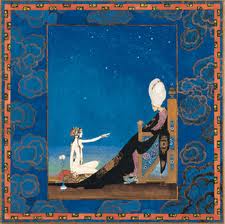Magic from The East: Those Arabian Nights
Above The Timberline
by Wayne Mergle
 ANCHORAGE Alaska—(Weekly Hubris)—10/3/11—Charles Dickens claimed it was his favorite book in all the world and that it was single-handedly responsible for his wanting to be a writer. The Brontés, as children, loved the book so much that it inspired them to write and act out their own imaginative tales in their own imaginative settings. Jorge Luis Borges said it is a book so vast that it may be responsible for most of Western literature. Voltaire and William Beckford, Coleridge and Thomas De Quincey all were so steeped in the book’s magic that their works can hardly be read without an awareness of its powerful influence. Isak Dinesen deliberately imitated it in her own magical and exotic short-story writing. C.S. Lewis and Angela Carter borrowed much from it. Salman Rushdie has said it is the one book he would want with him if marooned on a desert island. Walt Disney, as a boy, loved it. Hollywood has been inspired many times by it. And several contemporary writers, from John Barth to Robert Irwin, have acknowledged their obvious debt to it.There is, quite simply, nothing else in the literature of the world quite like it.What in the world then is this paragon among books?It is the book commonly known as The Arabian Nights, though it has many other names. And despite its enormous fame and amazing influence on some of the world’s greatest writers, it nevertheless remains a mysterious book which nobody really knows much about, including who really wrote it.
ANCHORAGE Alaska—(Weekly Hubris)—10/3/11—Charles Dickens claimed it was his favorite book in all the world and that it was single-handedly responsible for his wanting to be a writer. The Brontés, as children, loved the book so much that it inspired them to write and act out their own imaginative tales in their own imaginative settings. Jorge Luis Borges said it is a book so vast that it may be responsible for most of Western literature. Voltaire and William Beckford, Coleridge and Thomas De Quincey all were so steeped in the book’s magic that their works can hardly be read without an awareness of its powerful influence. Isak Dinesen deliberately imitated it in her own magical and exotic short-story writing. C.S. Lewis and Angela Carter borrowed much from it. Salman Rushdie has said it is the one book he would want with him if marooned on a desert island. Walt Disney, as a boy, loved it. Hollywood has been inspired many times by it. And several contemporary writers, from John Barth to Robert Irwin, have acknowledged their obvious debt to it.There is, quite simply, nothing else in the literature of the world quite like it.What in the world then is this paragon among books?It is the book commonly known as The Arabian Nights, though it has many other names. And despite its enormous fame and amazing influence on some of the world’s greatest writers, it nevertheless remains a mysterious book which nobody really knows much about, including who really wrote it.

Many people, if asked, would probably tell you that The Arabian NIghts is a collection of fairy tales for children. It is understandable that they would think this because most editions of the book are marketed and packaged that way and include mainly the tales that do support that description. Certainly, the book’s most famous tales—“Aladdin and the Wonderful Lamp,” “Ali Baba and the Forty Thieves,” “The Enchanted Horse,” and “The Seven Voyages of Sinbad the Sailor”—are among the best fairy tales ever.
But, in truth, The Arabian Nights is far more than a book of fairy tales and, in its entirety, is certainly not for children.
The Arabian Nights is a collection of fantastic tales from the Middle East, stories from many tellers, folk tales which probably originated in Persia, Arabia, India, and even China, tales of exotic worlds of magic, of the incredible. These stories, when first introduced to European readers, were unlike anything any Westerner had ever imagined. They were bold, shocking, exotic, beautiful, colorful, entrancing, and they drew readers into a world more exotic and strange than anything they had ever known before. They introduced the Western world to genies in bottles, to flying carpets and magical flying horses, to caliphs and sheiks and harem girls, to evil viziers, and to giant birds called rocs. They also made household names out of some of literature’s most delightful fictional characters: Aladdin, Scheherazade, Ali Baba, Ahmed and the Fairy Pari-Banou, Sinbad the Sailor, and the wonderful Caliph Haroun al-Rashid.
In addition to the fairy tales, there are also stories of lowlifes in the streets of Baghdad, Cairo and Damascus, realistic stories of medieval Muslim culture, erotic stories, fables, dirty jokes, stories of drug users and adulterers, epic tales of heroism, religious morality tales, cautionary tales, and lots of poetry and song. In fact, no one can quite agree on exactly how many stories exist because there are stories within stories within stories, and it is sometimes difficult to tell where one story leaves off and another begins.
In the original Arabic, the book is called Alf Layla wa-Layla, which translates as “One Thousand Nights and a Night.” The title comes from the 1,001 nights Scheherazade spent telling King Shahriyar to-be-continued yarns to keep him from beheading her. One early publication of the book was in 16 lengthy volumes. I know of a 12-volume set today, which claims to be complete. But most editions are condensed into a single volume.
Many translations exist today, some sanitized for children, some very much for adults, some for anyone who wants to escape from the dullness of real life into a night of fabulous fantasy. The book first appeared in Europe in 1704, with a French translation by Antoine Gaillard. Two years later, an English translation was released. The most famous and perhaps most complete of the book’s many translations is still the ten-volume collection by Sir Richard Burton, though there have been many other renditions over the decades and centuries.
Today’s readers, of course, are somewhat inured to the magic and the fantasy of The Arabian Nights. We are used to the outlandish, the fantastic, the bizarre. Books about vampires and werewolves, unicorns, fairies, mermaids, and wizards abound.
Yet I maintain that the magic is still there if a reader gives The Arabian Nights a chance. No other book, not even with all our Tolkiens, Grimms, Andersens, Rowlings, and Hoffmanns, has ever managed to create quite such a stunning jolt to the imagination of readers as this exotic book from long ago and far away.
3 Comments
Rick Kaiser
Wayne,
That sounds like just the kind of reading I need right about now, exotic and incredible storytelling.
Rick
Mandy Frank
Wayne, your time in Europe – was it in Stuttgart? Did you attend SHS or LHS as it became? What a wonderful writer you turned out to be.
Mandy
Wayne Mergler
Hi Mandy! It’s great to hear from you. Yes, I was at Stuttgart High with you my sophomore and part of junior year. Alan Thompson tells me he sees you at the reunions. I may see you, too, in November in Las Vegas. Thanks for the kind words. Wayne